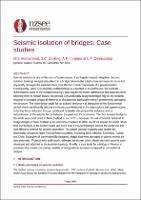Seismic Isolation of bridges: Case Studies

Download
Date
2022-04-27Authors
Mohammed, Mohammed
DeBisschop, Lani
Darling, Scott
Ibrahim, Ahmed
Metadata
Show full item recordAbstract
Seismic isolation is one of the most effective means of earthquake hazard mitigation. Seismic isolation bearings are typically placed in a bridge between the substructure and superstructure and physically decouple the superstructure from the horizontal components of a ground motion. Consequently, when an isolated bridge is subjected to earthquakes, the inelastic deformations occur in the isolators, reducing forces in the substructure and superstructure, allowing them to remain elastic. In contrast, conventionally designed bridges rely on the inelastic response in selected structural elements to dissipate the earthquake energy, permanently damaging the structure. The design goals for isolated bridges are a) elongation of the fundamental period which significantly reduces the forces, b) further force reduction through additional hysteretic damping, c) redistribution of the seismic forces between the piers and the abutments. The first isolated bridge in the world was constructed in New Zealand in the 1970’s; however, the use of seismic isolation in bridges in New Zealand is not common compared to other countries. More than 200 bridges in the United States and more than a thousand bridges around the world use this cost-effective method for seismic protection. This paper presents example case studies for seismically isolated bridges from different countries. Conventionally-designed bridges that were damaged in earthquakes are also presented. Projects with additional challenges are shown where elastic-restraint systems were developed and attached to the isolation bearings. Finally, a case study for a bridge in Mexico is presented that shows cost saving benefits of using seismic isolation compared to conventional designs.
